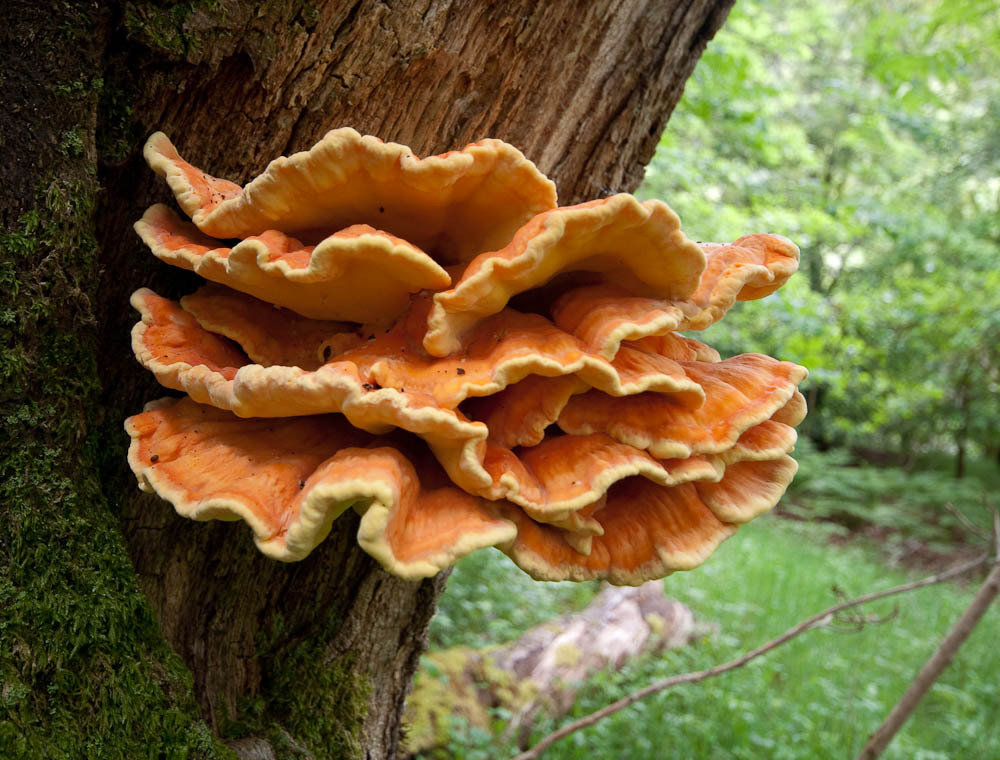Chicken of the Woods
Let's trace it back...
Classifications for Chicken of the Woods are as follows:
Domain: Eukarya
Kingdom: Fungi
Phylum: Basidiomycota
Class: Basidiomycetes
Order: Polyporales
Family: Polyporaceae
Genus: Laetiporus
Species: sulphureus
Common
names: Chicken of the Woods, Mushroom Chicken, Sulphur
Shelf, Rooster Comb
The official species name for Chicken of the Woods is
Laetiporus sulphureus. This mushroom is also more commonly known
as Sulphur Shelf, Mushroom Chicken, and Rooster Comb.
Chicken of the Woods is classified under the Domain Eukarya, because it is
multicellular. It is considered part of the Kingdom Fungi, because
it's cell walls contain chitin, a characteristic that distinguishes
plants from fungi. Chicken of the Woods is part of the phylum Basidiomycota, because this organism has fruiting bodies called basidium,
and is composed of filamentus structures called
hypae, which is also a
distinguishing characteristic of the Fungal Kingdom. Chicken of
the Woods is considered a bracket fungi, therefore it is classified in
to the Basidiomycetes class. There are usually four spores that
are born on each basidium, making this organism part of the Polyporales
order, and family Polyporaceae.
It is considered part of the Kingdom Fungi, because
it's cell walls contain chitin, a characteristic that distinguishes
plants from fungi. Chicken of the Woods is part of the phylum Basidiomycota, because this organism has fruiting bodies called basidium,
and is composed of filamentus structures called
hypae, which is also a
distinguishing characteristic of the Fungal Kingdom. Chicken of
the Woods is considered a bracket fungi, therefore it is classified in
to the Basidiomycetes class. There are usually four spores that
are born on each basidium, making this organism part of the Polyporales
order, and family Polyporaceae.
Laetiporus sulphureus
can be directly translated from latin.
The first part of the scientific name, Laetiporus,
can be translated to "cheer/gladden/delight."
This probably came
around because of the extraordinary coloration of this organism.
It is definately a bright, cheery color in the midst of its dead,
decaying natural surroundings.

The second part, sulphureus, can be translated in two parts. "Sulphur" because the fungus is yellow, like sulphur. "ureus" can be translated to "blight of plants." This makes sense because Chicken of the Woods is a parasitic organism, and feeds off of the dead and decaying material of trees.
*Translations found at
www.stars21.com*
Another organism that is classifed in the same phylum (basidiomycota) as Laetiporus sulphureus is Calvatia gigantea, or Giant Puffball. CLICK HERE to learn more about this distant relative to Laetiporus sulphureus.
If you would like to learn more about the HABITAT of Chicken of the Woods, CLICK HERE.